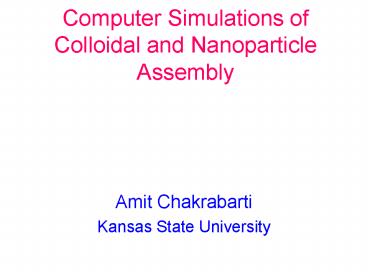Computer Simulations of Colloidal and Nanoparticle Assembly - PowerPoint PPT Presentation
1 / 26
Title:
Computer Simulations of Colloidal and Nanoparticle Assembly
Description:
... nonequilibrium models of aggregation and gelation (such as DLCA and RLCA Models) ... Gelation in Colloidal and Protein Solutions. Snapshots from Simulations ... – PowerPoint PPT presentation
Number of Views:208
Avg rating:3.0/5.0
Title: Computer Simulations of Colloidal and Nanoparticle Assembly
1
Computer Simulations of Colloidal and
Nanoparticle Assembly
- Amit Chakrabarti
- Kansas State University
2
Transition from Dispersed Phase to Clusters
- Grand Problem of small particles in a dispersed
phase coming together to form clusters - Parts of this grand problem
- limiting nonequilibrium models of aggregation
and gelation (such as DLCA and RLCA Models)
---- formation of fractal aggregates in
colloids and aerosols - models of nucleation and spinodal decomposition
- early studies of growth during precipitation ---
formation of precipitated crystalline solids
from solutions - Gelation in Colloidal and Protein Solutions
3
(No Transcript)
4
(No Transcript)
5
Snapshots from Simulations
6
(No Transcript)
7
Klabunde Sorensen Nanoparticles
- Metal particles with alkane chains
- Typically in Toluene
- van der Waals Steric Repulsion possible
ligand-ligand interactions
8
(No Transcript)
9
(No Transcript)
10
van der Waals for 5nm Au
11
Polymer ligand model
- Interaction potential
- Core/Core Vdw (depends on H for material)
- Ligand mixing
- Entropy loss
- Solvent effects
- Ligand compression
12
No ligand contact (ligDodecanethiol soltoluene)
13
Interparticle Potential Ligand overlap region
14
Interparticle Potential Ligand overlap with
compression
15
Potential Minimum
16
5nm Au NP/dodecanethiol lig. in toluene fv 0.02
17
5nm Au NP/dodecanethiol lig. in toluene fv 0.001
18
5nm Au NP dodecanethiol lig. in dodecane fv 0.02
19
Atomistic Model
- Atomistic Model
- Ligand bond lengths and angles conserved
- Dihedral angle Interaction between groups
separated by 3 bonds - LJ interactions between groups on same ligand
separated by 4 or more bonds - LJ interactions between all groups on different
ligands - Integrated van der Waals interaction between Au
core and groups on ligand - Au-S interactions not included due to lack of
surface diffusion of S groups once placed - S groups are placed randomly on surface of Au
core with a minimum separation 0.8rideal where
rideal gives required surface packing fraction of
SH groups
20
(No Transcript)
21
Hydrogen Bonding
22
DNA-induced Specific Interactions
23
(No Transcript)
24
(No Transcript)
25
(No Transcript)
26
Other Research Interests
- Wetting and Spreading of Polymers and
Nanodroplets at Surfaces































